|
- Interim Update 26th January 2011
Copyright
Reminder
The commentaries that appear at TSI
may not be distributed, in full or in part, without our written permission.
In particular, please note that the posting of extracts from TSI commentaries
at other web sites or providing links to TSI commentaries at other web
sites (for example, at discussion boards) without our written permission
is prohibited.
We reserve the right to immediately
terminate the subscription of any TSI subscriber who distributes the TSI
commentaries without our written permission.
The FOMC meeting changes nothing
The
Fed reacts to changes in market prices and economic data, so what the
Fed does in the future will be determined by what happens in the
interim to various financial markets (primarily, the stock market) and
economic numbers such as the monthly reports on employment and consumer
prices. Since the Fed governors don't know what's going to happen to
these markets and economic numbers, they have no idea what they will do
in the future. What, then, is the point of painstakingly analysing the
subtle changes in wording from one FOMC policy statement to the next?
In our opinion there is no point, but many people do it anyway. For example, in the article linked HERE
there is great significance attributed to the small differences between
the words chosen by the Fed in this week's statement and the words it
chose in the preceding statement.
All you really need to know is:
1. There were no new policies announced at the conclusion of this week's FOMC meeting.
2. If the stock market tanks at some point over the next few months,
the Fed will almost certainly react by stepping up its
inflation-promoting efforts.
3. If the stock market continues its up-trend over the next few months
and the T-Bond market tanks, the Fed will become concerned about an
inflation problem and will cut back on its inflation-promoting efforts.
The Stock Market
The
US stock market remains dull. This is good news for the bulls, because
with the market 'overbought' and with sentiment near an optimistic
extreme any increase in volatility will almost certainly be to the
downside.
The action in China's stock market has been a little more interesting
of late, in that the Shanghai Stock Exchange Composite Index (SSEC) has
dropped back to an area of important support. The following daily chart
shows the situation as at the completion of trading on Wednesday. A
daily close below 2600 would constitute a breakdown and would suggest
that the SSEC was headed back to its July-2010 low (the lowest level of
the past 18 months).
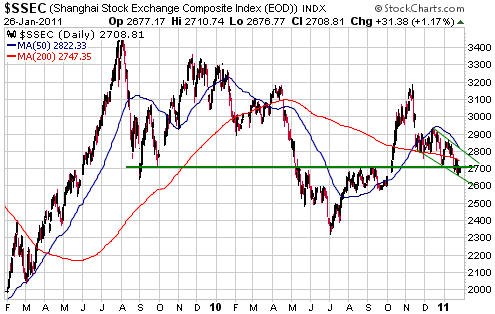
Experienced traders
looking for an effective way to hedge short-term downside risk in the
stock market could purchase some VIX June-2010 $25 call options, which
are currently priced at around $2.60. We suspect that all it would take
is a quick 10% stock market decline at any time within the next three
months to generate a sufficiently large upward spike in the Volatility
Index (VIX) to lift the price of these options to at least $5.
Gold and
the Dollar
Gold
Over the past couple of weeks we mentioned that the 1320s was the most
likely area for a short-term bottom in the US$ gold price. Gold dropped
to this area during the first half of this week and has initially
bounced. Furthermore, the price decline to the $1320s was accompanied
by a decline in Market Vane's bullish percentage to 63 and by Central
Gold Trust (GTU) trading at a discount to its net asset value for the
eighth consecutive trading day. This means that when the price dropped
to support at $1320 sentiment was consistent with what we'd expect to
see at a short-term bottom. This doesn't guarantee that a short-term
bottom is in place, but the odds are in favour of it.
The initial rebound from this week's low should encounter stiff resistance in the $1360s.
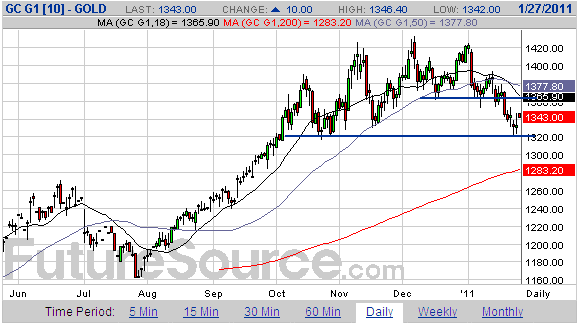
Sometimes a market
will do just enough to convince us that we are wrong, before reversing
course and doing what was originally expected. Such is the case with
gold in euro terms (gold/euro).
During previous occasions over the past 10 years when gold/euro became
as extended to the upside as it was last May-June, the ensuing
correction never ended until the price had fallen far enough to touch
its 200-day moving average. Consequently, our expectation during the
June-October period of last year was that gold/euro would test its
200-day moving average before commencing the next intermediate-term
advance in its long-term bull market. We were a little surprised, then,
when gold/euro broke to a new high in November, thus seemingly
deviating from its well-established pattern.
As it turned out, November's upside breakout was a 'fakeout'. The
gold/euro correction that began in June of 2010 is still in progress
and has finally resulted in a test of the 200-day moving average. The
correction may not be over, but it appears to us that the maximum
downside risk in gold/euro is no more than 10% on both a short-term and
an intermediate-term basis. The likely downside is a lot less than 10%.
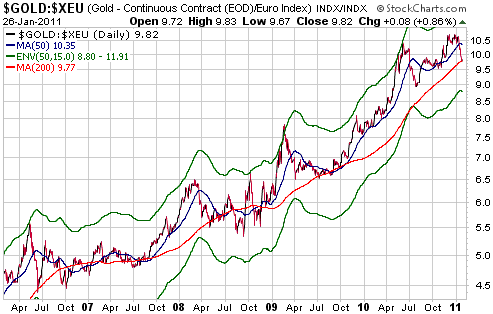
Gold Stocks
Current Market Situation
The HUI ended last week just above support at 500. We said in the
Weekly Update that it could spike a little lower before starting to
rebound, but that a rebound should soon begin. As it turned out, the
HUI dropped a little below 500 on Tuesday -- to its 200-day moving
average in the mid-490s -- before rebounding strongly on Wednesday.
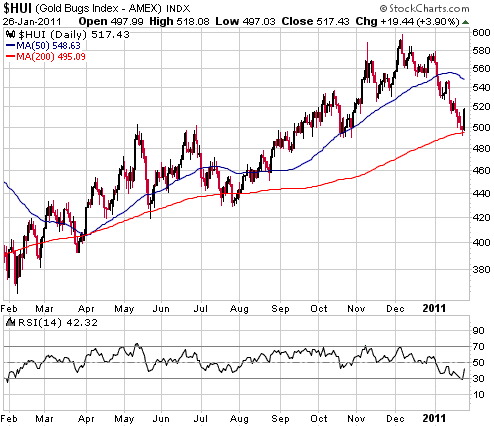
The magnitude of the
HUI's decline from its early December high to this week's low is within
the bounds of a routine short-term pullback. For example, it is roughly
the same (16%-17%) as the pullback that occurred last May. And as was
the case last May, an upward reversal has immediately followed a
marginal breach of the 200-day moving average. Therefore, one of the
two most likely scenarios is that a correction low is now in place.
The second of the two most likely scenarios is that we've just seen the
low for the first downward leg of an intermediate-term correction.
Under this scenario the HUI would be expected to rebound and then
decline to the ultimate correction low. A typical counter-trend rebound
would take the HUI back to the vicinity of its 50-day moving average.
Either way, a short-term buying opportunity has occurred.
Under-valued gold producers with >150K-oz/yr of current production
Over the past 6 months the stock market has ruthlessly marked down the
stock prices of gold producers that missed production forecasts, even
if the miss was relatively minor. Also, any gold producer that
announced potential obstacles to its future growth has taken a
disproportionately large hit in the stock market. The result of this
harsh treatment is that some of the best bargains within the gold
sector can be found amongst the stocks of companies with production in
the 150K-400K oz/yr range. In some cases it almost seems as if the
stock market is viewing current profitable production as a negative,
preferring, instead, the stocks of companies that are years away from
being able to generate any income from the mining of gold.
Golden Star Resources (GSS) is a good example of the phenomenon we are
referring to. GSS reached US$6/share in early November, but then
announced that it would miss its 2010 production forecast by about 10%.
This caused the stock to plunge and set in motion the downward trend
clearly evident on the following daily chart. At Tuesday's low of
US$3.41, GSS had lost 43% of its value. The gold price was down by only
7% over the same period.
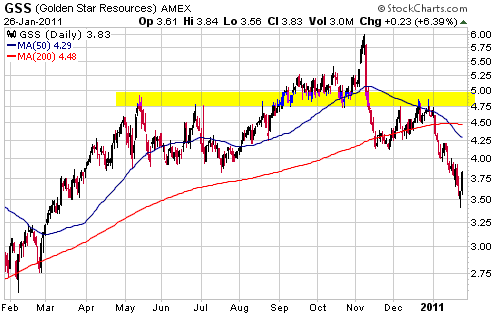
Due to its recent
price action the Ghana-based in-ground gold resources of GSS now trade
at a discount to the Ghana-based in-ground gold resources of some
exploration-stage miners. So, would we be buyers of GSS near its
current price?
The answer is a qualified yes. We actually did purchase a small initial
position for our own account in the $3.50s on Tuesday, but we don't
plan to make a substantial addition to this position unless the stock
price drops to the low-$3 area*. Also, we most likely won't add GSS to
the TSI Stocks List unless it drops to the low-$3 area. This is not
because we expect the stock to drop that far or because it doesn't
offer reasonable value near its present level; it's because we already
have plenty of exposure in both our own account and in the TSI List to
150K-400K oz/yr gold producers that are as attractive, or more
attractive, than GSS. We are referring to Jaguar Mining (JAG),
Minefinders (MFN), Northgate Minerals (NXG), and Resolute Mining (ASX:
RSG). If we were building a gold-stock portfolio from scratch we would
be inclined to buy these stocks before we would buy GSS.
The one thing that the above-mentioned stocks have in common is failure
to achieve expected levels of production and/or production cost over
the past 9 months. Each of them, however, has the potential to shine
during 2011 due to the remedial actions that were taken last year and
the fact that operational improvement is not factored into current
stock prices.
*One
point we occasionally make is that successful speculation doesn't
require accurate short-term forecasting. You don't even need to have an
opinion on the likely short-term direction of prices. You should,
however, think ahead and plan how you would react under different
short-term scenarios. For example, we don't know what will happen to
the stock price of GSS over the next few weeks, but we do know that if
there were no meaningful change to the company's operations then we
would: a) make a significant addition to our exposure if the stock
price fell to the low-$3 area, and b) exit our current position if the
stock price rebounded to the vicinity of resistance at $4.75.
Australian gold stocks
By "Australian gold stocks" we mean the stocks of companies that
produce most of their gold in Australia, as opposed to stocks that are
listed on the Australian Stock Exchange (ASX). For example, Resolute
Mining is listed in Australia, but most of its gold production comes
from Africa so for the purpose of this discussion it doesn't qualify as
an Australian gold stock. Crocodile Gold (TSX: CRK), however, does
qualify as an Australian gold stock, even though it trades on the
Toronto Stock Exchange (TSX). This is because all of CRK's production
comes from Australia.
Part of the reason that many Australian gold stocks have had lacklustre
performance over the past year is reflected by the following chart,
which shows that the A$-denominated gold price has been in
'consolidation mode' since February of 2009. This occurred because the
A$ strengthened against the US$ by roughly as much as gold strengthened
against the US$. The other part of the reason is that over the same
period the cost of producing gold in Australia continued to rise. The
overall effect was downward pressure on gold-mining profit margins.
To put it another way, Australian gold stocks have been weighed down
because the A$ managed to hold its own relative to gold at the same
time as it lost purchasing power.
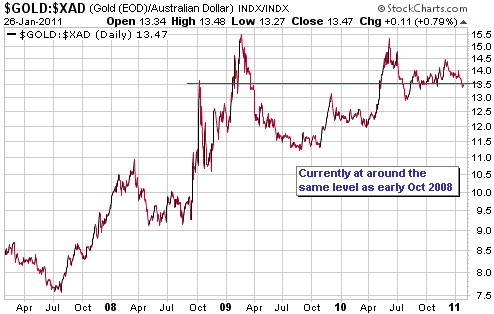
The TSI gold-stock
selections that can be classed as "Australian", by virtue of producing
more than half of their gold from operations located in Australia, are:
Catalpa Resource (ASX: CAH), Crocodile Gold (TSX: CRK) and Northgate
Minerals (NXG). These stocks should perform relatively well once the A$
begins to trend downward against the US$.
The A$ has the potential to fall a long way against the US$ and against
gold over the next 12 months. However, we said the same thing at this
time last year. During 2010 the A$ did roughly what it was supposed to
do (from our perspective) during the first half of the year (it
weakened against the US$ and gold, thus reducing the extent of its
over-valuation), but then ramped upward during the year's second half
in response to increased speculation in equities and industrial
commodities.
Currency Market Update
It is reasonable to expect that the US$ will continue its downward
drift for as long as -- but for no longer than -- the stock market
continues its upward drift. A turning point could occur at any time.
Currency traders will no doubt be keeping a close eye on the political
situation in Ireland over the weeks ahead. It looks like the Irish will
go the polls to elect a new government during the second half of next
month, with the country's financial bail-out being one of the main
campaign issues. At this stage the election doesn't appear to be a big
threat to euro-zone stability, but it will probably have some effect on
the currency market. As noted in a Financial Times article on Monday:
"The two parties
considered most likely to form a coalition government after the
election have made no secret of their intention to seek a renegotiation
of the terms of rescue package from the European Union and the
International Monetary Fund -- in particular the interest rate charged
and the treatment of bondholders who lent to Ireland's collapsed banks."
Update
on Stock Selections
(Notes: 1) To review the complete list of current TSI stock selections, logon at http://www.speculative-investor.com/new/market_logon.asp
and then click on "Stock Selections" in the menu. When at the Stock
Selections page, click on a stock's symbol to bring-up an archive of
our comments on the stock in question. 2) The Small Stock Watch List is
located at http://www.speculative-investor.com/new/smallstockwatch.html)
 Pretium Resources (TSX: PVG). Shares: 81M issued, 84M fully diluted. Recent price: C$6.05 Pretium Resources (TSX: PVG). Shares: 81M issued, 84M fully diluted. Recent price: C$6.05
We introduced PVG and its huge low-grade Snowfield/Brucejack gold project in last week's Interim Update.
An article about Pretium that was posted at Mineweb.com a couple of days ago contained the following interesting comment:
"...there is potential to
start mining a high grade section to develop good cashflow while
continuing to explore the main lower grade bulk tonnage zones of this
potentially enormous deposit. He [Pretium CEO Bob Quartermain]
believes that ultimately it will make sense to combine
Snowfield/Brucejack with KSM into a single massive mine, but recognises
that this type of operation would be well beyond the capabilities of a
junior to finance and operate.
But meanwhile Pretium is
undertaking a significant drill programme to explore the high grade
zones and if these are as consistent as expected the company could move
closer towards a smaller scale near-term mining operation."
Until we read this article we weren't aware of the potential to build a
smaller-scale mining operation to exploit a high-grade portion of the
overall deposit. Pretium's speculative appeal will be enhanced if this
potential is confirmed by drilling results over the months ahead.
 Jaguar Mining (NYSE and TSX: JAG). Shares: 84M issued, 88M fully diluted. Recent price: US$6.32 Jaguar Mining (NYSE and TSX: JAG). Shares: 84M issued, 88M fully diluted. Recent price: US$6.32
JAG's stock price probed intermediate-term support on Tuesday and then rebounded along with most gold stocks on Wednesday.
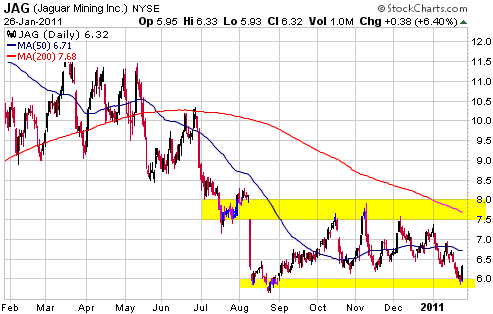
The reason that GSS's
stock price was hit so hard in November after the company announced a
reduction in its production forecast was that the market had become
convinced that GSS had put its forecast-missing days behind it. The
miss therefore caused an immediate plunge in confidence. JAG is in a
very different situation, in that it would be difficult for confidence
to fall much further. In effect, its current low valuation is the
market's expression of a total lack of belief in the ability of JAG's
management to significantly improve the company's mining operations.
This greatly reduces the stock's vulnerability to a negative surprise.
We think that JAG is a good candidate for new buying near its current
price, although it could be a few months before the remedial actions
that were taken last year start to have a meaningful positive effect on
the reported operational performance.
 Our
Northgate Minerals (NXG) trading position was stopped out on Monday for
a loss of 17%. There is still a longer-term NXG position in the TSI
Stocks List. Our
Northgate Minerals (NXG) trading position was stopped out on Monday for
a loss of 17%. There is still a longer-term NXG position in the TSI
Stocks List.
Chart Sources
Charts appearing in today's commentary
are courtesy of:
http://stockcharts.com/index.html
http://www.futuresource.com/

|

